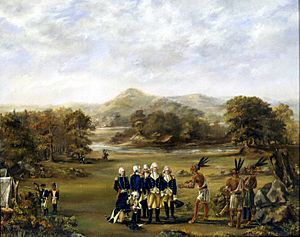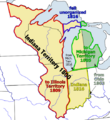Indiana Territory facts for kids
Quick facts for kids Territory of Indiana |
|||||||||||||
|---|---|---|---|---|---|---|---|---|---|---|---|---|---|
| Organized incorporated territory of the United States | |||||||||||||
| 1800–1816 | |||||||||||||
|
Flag
|
|||||||||||||
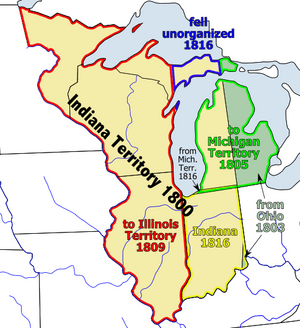 |
|||||||||||||
| Capital | Vincennes (1800–1813) Corydon (1813–1816) |
||||||||||||
| Population | |||||||||||||
|
• 1800
|
2,632 | ||||||||||||
|
• 1810
|
24,520 | ||||||||||||
|
• 1816
|
63,897 | ||||||||||||
| Government | |||||||||||||
| • Type | Organized incorporated territory | ||||||||||||
| Governor | |||||||||||||
|
• 1800–1812
|
William Henry Harrison | ||||||||||||
|
• 1812–1813
|
John Gibson (acting) | ||||||||||||
|
• 1813–1816
|
Thomas Posey | ||||||||||||
| Secretary | |||||||||||||
|
• 1800–1816
|
John Gibson | ||||||||||||
| History | |||||||||||||
|
• Established
|
4 July 1800 | ||||||||||||
|
• Treaty of Grouseland signed
|
March 1805 | ||||||||||||
|
• Michigan Territory created
|
June 30, 1805 | ||||||||||||
|
• Representation in Congress
|
December 12, 1805 | ||||||||||||
|
• Illinois Territory created
- Treaty of Fort Wayne - Legislature popularly elected - Tecumseh's War - War of 1812 - Constitution drafted & adopted |
March 1, 1809 September 30, 1809 November 1809 1811–1812 1812–1814 June 1816 |
||||||||||||
|
• Granted Statehood
|
11 December 1816 | ||||||||||||
|
|||||||||||||
The Indiana Territory was a part of the United States that existed from 1800 to 1816. It was created by the U.S. Congress and signed into law by President John Adams. On December 11, 1816, the remaining part of the territory became the state of Indiana.
When it was first formed, the Indiana Territory was very large. It covered about 259,824 square miles (673,000 km2). But its size got smaller over time. This happened when the Michigan Territory was created in 1805 and the Illinois Territory was formed in 1809.
The Indiana Territory was the first new territory made from the lands of the Northwest Territory. The Northwest Territory was set up in 1787. The first capital of the Indiana Territory was Vincennes, a settlement near the Wabash River. Later, in 1813, the capital moved to Corydon, which was closer to the Ohio River.
William Henry Harrison was the first governor of the territory. He worked on agreements with Native American tribes to gain land for the U.S. government. This opened up large areas for new settlers. In 1809, the U.S. Congress created a two-part law-making body for the territory. It had a House of Representatives, whose members were chosen by the people, and a Legislative Council.
The territorial government also started planning for roads and schools. However, becoming a state was delayed because of war. During Tecumseh's War, Harrison led soldiers in the Battle of Tippecanoe in 1811. He also led troops in Canada during the War of 1812.
After Harrison left his role as governor, Thomas Posey took over. But a group led by Congressman Jonathan Jennings became very powerful. They pushed for the territory to become a state.
In June 1816, a meeting was held in Corydon to write a state constitution. This constitution was approved on June 29, 1816. Elections were held in August for the new state government. The new leaders took office in November, and the territory officially ended. On December 11, 1816, President James Madison signed the law that made Indiana the 19th state in the Union.
Contents
Where was the Indiana Territory located?
| Historical population | ||
|---|---|---|
| Year | Pop. | ±% |
| 1800 | 5,641 | — |
| 1810 | 24,520 | +334.7% |
| Source: 1800–1810 (1800 also includes Illinois and Mackinac County, Michigan) | ||
When the Indiana Territory was formed in 1800, it included the western part of the Northwest Territory. This area started at the Ohio River and went northeast to Fort Recovery in today's western Ohio. It then went north to the border between the United States and Canada.
The territory first included most of what is now Indiana. It also had all of present-day Illinois and Wisconsin. Parts of Minnesota east of the Mississippi River were included too. Nearly all of the Upper Peninsula and the western half of the Lower Peninsula of today's Michigan were part of it. There was also a small strip of land in present-day Ohio. This Ohio land became part of Ohio when it became a state in 1803.
In 1803, when Ohio became a state, the Indiana Territory's border moved. It shifted to the mouth of the Great Miami River. Also, the eastern part of present-day Michigan was added to the Indiana Territory. The territory's size got smaller again in 1805 when the Michigan Territory was created to the north. It shrunk even more in 1809 when the Illinois Territory was formed to the west.
How many people lived in the Indiana Territory?
In 1800, the Indiana Territory had 5,641 white people. However, there were many more Native Americans, possibly between 20,000 and 75,000. The 1800 census showed these numbers for its counties:
| Rank | County | Population |
|---|---|---|
| 1 | Knox | 2,517 |
| 2 | Randolph | 1,355 |
| 3 | St. Clair | 1,103 |
| 4 | Michilimackinac | 551 |
| Unincorporated | 115 | |
| Indiana Territory | 5,641 |
By 1810, after the Michigan and Illinois Territories were created, the population of the remaining Indiana Territory grew. The 1810 census showed 24,520 people in the four counties within what is now Indiana:
| Rank | County | Population |
|---|---|---|
| 1 | Knox | 7,945 |
| 2 | Dearborn | 7,310 |
| 3 | Clark | 5,670 |
| 4 | Harrison | 4,699 |
| Indiana Territory | 24,520 |
How was the Indiana Territory governed?
The government of the Indiana Territory changed over time. It went through three main stages before it became a state.
- Stage 1 (1800-1804): In the first stage, the U.S. President and Congress chose the governor, secretary, and three judges. Local people did not vote for these leaders. These officials made the laws for the territory.
- Stage 2 (1805-1816): In the second stage, adult men who owned land could vote for members of the lower house of the legislature. The president chose five members for the upper house from a list given by the lower house. Both houses could make laws, but the governor could still say no to any law (veto it).
- Stage 3 (1816): When the territory had 60,000 free people, it could ask Congress to become a state.
In 1803, a change was made. The territory could move to the second stage if most landowners wanted it. In 1810, the rules changed again. All free adult men who paid taxes and had lived in the territory for at least a year could vote, not just landowners.
Territorial Governors
William Henry Harrison was chosen as the first governor of the Indiana Territory. He was appointed by President John Adams. Later, Presidents Thomas Jefferson and James Madison also appointed governors for the territory.
| # | Name | Took office | Left office | Appointed by |
|---|---|---|---|---|
| 1 | William Henry Harrison | May 13, 1800 (appointed); January 10, 1801 (took office) |
December 28, 1812 (resigned) | John Adams, Thomas Jefferson, James Madison |
| 2 | John Gibson | December 28, 1812 (appointed) Acting governor: July 4, 1800 – January 10, 1801; June 1812–May 1813 |
March 3, 1813 | James Madison |
| 3 | Thomas Posey | March 3, 1813 (appointed); May 1813 (took office) | November 7, 1816 | James Madison |
Judges and Courts
In the first stage of government, three judges helped the governor. They made laws and also served as the main court. The president appointed these judges. Later, the governor was given the power to appoint them.
When the territory moved to the second stage in 1805, the legislature took over law-making. The judges then focused only on court cases. As the territory moved closer to statehood, new circuit courts were set up in 1814.
Legislature (Law-making body)
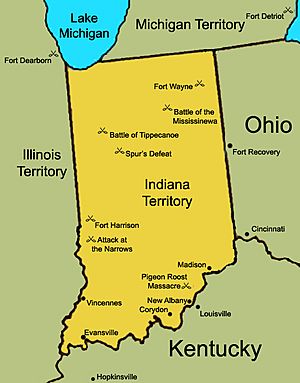
When the territory entered its second stage, people could elect representatives to the House of Representatives (the lower house). The governor chose the five members of the Legislative Council (the upper house).
The first legislature met in Vincennes in 1805. It had seven representatives from different counties. Governor Harrison still had the power to veto laws. The judges no longer had law-making powers.
In 1809, after the Illinois Territory was formed, the U.S. Congress changed the legislature. Members of both the House of Representatives and the Legislative Council were elected by popular vote. This two-part legislature stayed the same until the territory became a state.
Representatives in Congress
The Indiana Territory also had a delegate in the U.S. House of Representatives. This delegate could speak, suggest laws, and work on committees. However, they could not vote on laws.
Benjamin Parke was the first delegate chosen by the territory's legislature. Later, in 1809, Congress allowed the people of the territory to elect their delegate directly. Jonathan Jennings was the first person chosen this way. He was reelected several times and later became the first governor of Indiana.
| Delegate | Years | Party |
|---|---|---|
| Benjamin Parke | December 12, 1805 – March 1, 1808 | none |
| Jesse Burgess Thomas | October 22, 1808 – March 3, 1809 | Democratic-Republican |
| Jonathan Jennings | November 27, 1809 – December 11, 1816 | none |
Territory's Money
At first, the U.S. government paid the salaries of the governor, judges, and secretary. This cost about $5,500 per year. Other officials, like the treasurer and attorney general, were paid by the territory itself.
When the territory moved to the second stage, the U.S. government still paid some salaries. But the territory had to pay for its legislature and other officials. This cost about $10,000 per year.
The territory got most of its money from selling federal lands. It also collected taxes on goods and licenses. During the War of 1812, the territory's money problems got worse. Many people couldn't pay their taxes. At one point in 1813, the territory only had $2.47 left! To fix this, taxes were changed, and new ways to get money were found. The growth of the population also helped improve the territory's finances.
What were the main political issues?
The biggest political issue in Indiana Territory was slavery. But there were other important topics too. These included how to deal with Native Americans and how the territory's size would change. People also wanted more self-government and a voting representative in Congress. There were also ongoing complaints about Governor Harrison's actions.
Most of these issues were settled before Indiana became a state. The creation of the Michigan and Illinois Territories solved the debate about the territory's size. As the government became more democratic, power shifted from the governor to elected lawmakers. The debate over slavery was settled in 1810.
The Debate over Slavery
In 1802, leaders from the Indiana Territory asked Congress to allow slavery for ten years. They believed this would bring more settlers and help the economy grow. They also wanted slaves and their children to remain slaves even after the ten years. However, Congress did not act on this request.
So, in 1803, Governor Harrison and the judges passed laws that allowed slavery in a different way. They used "indentured servitude" laws. This meant adult slaves could be brought into the territory and forced to work for a set number of years.
This idea of allowing slavery faced strong opposition from the Quakers who lived in the eastern part of the territory. They formed a group against slavery. In 1809, the anti-slavery group gained power in the legislature. They stopped many of Harrison's plans for slavery. In 1810, the territorial legislature ended the indenturing laws that Harrison had put in place. This decision helped make Indiana a free state.
Moving the Capital City
The capital of the Indiana Territory was in Vincennes from 1800 to 1813. After the Illinois Territory was formed in 1809, Vincennes was no longer in the center of the territory. It was now on the far western edge.
Lawmakers also worried that Vincennes might be attacked during the War of 1812. So, they decided to move the capital to a place closer to where most people lived. Several towns were considered, but on March 11, 1813, Corydon was chosen. The move became official on May 1, 1813.
Harrison liked Corydon because he had helped found it and owned land there. A new county courthouse was being built in Corydon. The government realized they could use this new building for their meetings, which would save money. So, the capital moved to Corydon.
History of the Indiana Territory
The land that became the Indiana Territory was once part of the Northwest Territory. This larger territory was created in 1787. It set up a plan for how western lands would be governed and how they could become states. The Northwest Territory was later divided into smaller territories. These included the Indiana Territory (1800), Michigan Territory (1805), and Illinois Territory (1809). These areas eventually became the states of Ohio, Michigan, Indiana, Illinois, Wisconsin, and eastern Minnesota.
How the Territory Got its Name
The name Indiana means "Land of the Indians." This name shows that most of the area north of the Ohio River was still home to Native American tribes.
The name Indiana was first used in 1768. At that time, a group of Native American tribes gave some land in what is now West Virginia to a trading company. The company named this land "Indiana" to honor its previous owners. In 1798, the U.S. Supreme Court ended the company's claim to the land. Two years later, in 1800, Congress used the name "Indiana" for the new territory.
Conflicts over Land
The U.S. government planned to expand westward. This led to increasing tensions with the Native Americans who lived on these lands. These conflicts became known as the Northwest Indian War.
In 1791, American forces suffered a major defeat. Nearly 1,000 Native American warriors, led by Chief Little Turtle, attacked an American camp. This battle, known as St. Clair's defeat, was the U.S. Army's worst defeat by American Indians.
In 1794, General Anthony Wayne led American forces to victory at the Battle of Fallen Timbers. This battle was a turning point. Americans gained control of important areas and built forts.
The Treaty of Greenville in 1795 ended the Northwest Indian War. Native American tribes gave up large parts of southeastern Indiana and Ohio to the U.S. government. This treaty led to more settlers moving into the Indiana Territory.
Forming the Territory
The U.S. Congress created the Indiana Territory on May 7, 1800. It officially began on July 4, 1800. This new territory was formed from the Northwest Territory before Ohio became a state.
President John Adams appointed William Henry Harrison as the first governor. Harrison arrived in January 1801. Until then, John Gibson, the territorial secretary, served as acting governor.
The governor and three judges made the laws and served as the highest court. Harrison had a lot of power. He could appoint officials and divide the territory into districts. Vincennes, an old French trading post, became the first capital. It was the largest settlement with 714 people in 1800.
Harrison wanted to expand the territory. In 1803, President Thomas Jefferson allowed him to make treaties with Native American tribes. Harrison oversaw 13 treaties. These treaties gave over 60 million acres (24 million hectares) of land from Native American tribes to the U.S. government. This included most of southern Indiana.
The Treaty of Vincennes (1803) was the first of these treaties. It recognized American ownership of land around Vincennes. The Treaty of Grouseland (1805) secured more land in south-central Indiana. After the Treaty of Fort Wayne (1809), which gave the U.S. government over 250 million acres (100 million hectares) in central Indiana and eastern Illinois, tensions grew very high between Native Americans and settlers.
Many new settlers came to the territory because land was cheap. Large settlements grew near the Great Lakes, Ohio River, Wabash River, and Mississippi River. However, much of the inner land was still inhabited by Native American tribes.
The District of Louisiana
From 1804 to 1805, the Indiana Territory's governor and judges also managed the District of Louisiana. This was a temporary arrangement for the lands bought in the Louisiana Purchase. The district included all Louisiana Purchase lands north of the 33rd parallel.
During this time, Governor Harrison and the judges made laws for the Louisiana district. However, local residents, who were used to French laws, did not like the American laws. This temporary arrangement lasted only nine months. Then, the Louisiana Territory was created with its own government.
One important event during this time was the Treaty of St. Louis (1804). In this treaty, the Sac and Fox tribes gave up land in what is now Missouri, Illinois, and Wisconsin. Later, anger over this treaty led these tribes to side with the British in the War of 1812.
Tecumseh's War
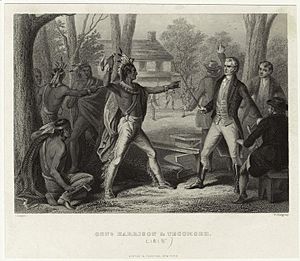
Tensions between Native Americans and settlers led to more fighting. A resistance movement grew around two Shawnee brothers, Tecumseh and Tenskwatawa (The Prophet). This became known as Tecumseh's War. Tenskwatawa told tribes that a powerful spirit would protect them if they fought against the white settlers. He urged them to reject white ways, like clothing, whiskey, and guns.
In 1810, Tecumseh and about 400 warriors went to Vincennes. He demanded that Governor Harrison cancel the Treaty of Fort Wayne. Harrison refused. Tecumseh left peacefully but was very angry. He then traveled south to try and unite other tribes against the Americans.
In 1811, while Tecumseh was away, Harrison was allowed to march his army against the Native American confederation. Harrison moved north with over 1,000 men to try and make the Shawnee agree to peace. On November 6, tribal warriors launched a surprise attack on Harrison's army. This battle was the Battle of Tippecanoe. Harrison won the battle on November 7. This victory made Harrison famous. After the battle, more of central Indiana became safe for settlers.
Becoming a State
On December 5, 1804, Governor Harrison announced that the Indiana Territory would move to the second stage of government. Voters elected members to the House of Representatives for the first time in January 1805. The governor chose the members of the Legislative Council.
Between 1805 and 1811, parts of the Indiana Territory were separated to form the Michigan Territory and the Illinois Territory. Governor Harrison also made more treaties with Native American tribes. This opened up millions of acres for sale and settlement in southern Indiana and most of Illinois. In 1810, anti-slavery supporters in the legislature also ended the indenturing laws.

In 1811 and 1812, Jonathan Jennings, who was the territory's elected delegate to Congress, asked Congress for permission to write a state constitution. At that time, the territory's white population was only 24,520. This was much less than the 60,000 people needed to become a state. Congress did not act on the request, mainly because the War of 1812 had started.
The War of 1812
Tecumseh's war joined with the War of 1812 when the Native American confederation allied with the British. In May 1812, Chief Little Turtle held a meeting. Most tribes decided to stay neutral. But Tecumseh continued to fight alongside the British.
Some of Tecumseh's followers who stayed behind continued to raid settlements. They also fought in the Siege of Fort Harrison, which was the U.S. Army's first land victory in the war. John Gibson served as acting governor during the war. After Harrison resigned, Gibson continued as acting governor until Thomas Posey arrived in May 1813.
Other battles happened in what is now Indiana, like the Siege of Fort Wayne. Many incidents between settlers and tribes led to deaths. The Treaty of Ghent in 1814 ended the war. This made American settlers feel safer from attacks.
Achieving Statehood
After the war, efforts to make Indiana a state started again in 1815. A census showed the territory's population had reached 63,897. This was enough to become a state.
There was a disagreement between Jennings and Governor Posey about statehood. Posey thought it was too early. He argued that a state government would cost too much money. He also thought there wouldn't be enough people to fill all the new state jobs. Posey also supported slavery, which his opponents, like Jennings, were against.
If Indiana became a state, it would lose money from the federal government. So, new taxes would be needed. Supporters of statehood argued that people were ready to elect their own officials. They wanted representatives in Congress who could vote for them.
On April 19, 1816, President James Madison approved a law that allowed Indiana to hold a meeting to write a state constitution. Elections for the 43 delegates were held on May 13, 1816. The meeting started on June 10, 1816, in Corydon. The state's first constitution was signed on June 29, 1816, and it went into effect right away.
Elections for the new state government were held on August 5, 1816. Jonathan Jennings defeated Posey and became the first governor of Indiana. Christopher Harrison became the first lieutenant governor. William Hendricks was elected to the U.S. House of Representatives.
In November 1816, Congress approved the state constitution. The first meeting of the General Assembly for the state of Indiana was on November 4, 1816. Jennings and Harrison officially took office on November 7, 1816. On December 11, 1816, President Madison signed the law that officially made Indiana the 19th state in the Union. This ended the Indiana Territory.
How is the Indiana Territory remembered today?
The Indiana Territory is remembered at an annual event in Corydon. This event takes place around the old territorial capitol building. People dress in old-fashioned clothes and act out historical events. Other festivals happen in Vincennes and Madison.
Historical markers and monuments also remember this time period. For example, a marker in LaPorte County celebrates the northern boundary of the Indiana Territory. This boundary was set when the Michigan Territory was formed.
Images for kids
See also
 In Spanish: Territorio de Indiana para niños
In Spanish: Territorio de Indiana para niños



